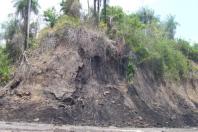The Dark Side of Serbia’s Oil Shale Fairy Tale
BALKANS: The Dark Side of Serbia’s Oil Shale Fairy Tale
BELGRADE, Jan 19 2012 (IPS) - According to an old Serbian fairy tale, God tells a poor man who enters a gold mine that no matter what he chooses to do inside, he’ll be sorry when he leaves. If he takes some gold, he’ll be sorry for not taking more; if he doesn’t, he’ll be sorry for not taking any at all.
Modern Serbia now finds itself in a similar situation to the hero of that ancient tale.
Experts have revealed that parts of South-eastern Serbia lie on two billion tons of oil shale that could be processed into oil worth roughly 60 billion dollars in the next decade.
Further, the introduction and implementation of sufficient technology to turn the crude into derivates could reap between 120 and 180 billion dollars, according to studies by several domestic and international mining institutes and the Serbian ministry of environment and mining, which kept this secret carefully guarded until early January.
“It is our goal to introduce the most modern international technology so that oil shale can become a resource that will significantly improve the energetic balance of Serbia,” Oliver Dulic, minister of environment and mining, said last week on a visit to the small town of Aleksinac, some 210 kilometres south-east of the capital.
Dulic declined to comment on the fact that the European Union (EU), which is oriented towards reusable and clean energy sources, is unwilling to finance the project.
However, state secretary at the ministry of environment and mining, Zdravko Dragosavljevic, announced that the corporate players itching to enter the shale extraction race would be announced by mid 2012.
He told journalists last week that a little known British-Russian consortium known as Zao Star and the Estonian Eesti Energia expressed interest in investing in extraction in Aleksinac, but promised that the project will go to a tender.
"Production could start in 2016 or 2017. This is a long term job, not only for this government but for governments to come," he said, referring to press reports that the project could be the current government's ticket to victory in the upcoming May elections.
The town and its surroundings coalmines, which have been closed since a fatal disaster in the 1980s claimed the lives of 90 miners, lie on the largest bulk of oil shale reserves.
“Our estimates say that oil shale could be exploited for several decades, with an annual production of between 500,000 and 600,000 tons of crude, 100 megawatts of electricity and enough thermal energy to heat Aleksinac and neighbouring villages,” Dulic added.
Yearning for growth
For the last few years, Serbia has barely managed to stay afloat in the tides of the global economic downturn, paying the price for moderate economic improvement with high unemployment and modest salaries.
The country’s unemployment rate soared to 23.7 percent in November 2011, up from just 19 percent in 2010. This is the highest level of unemployment since former dictator Slobodan Milosevic was ousted more than a decade ago, the national statistics bureau said Monday.
A breakdown of the data revealed the youth population to suffer the most, with an unemployment rate of 51.9 percent for the 15-24 age group and 32.0 percent for those between the ages of 25 and 34. But the discovery of shale deposits promises a leg-up for the struggling economy. Dulic proclaimed, “Several thousand people will be employed” once the operation is put into motion with the investment of between 700 and 800 million dollars.
In fact, Dulic’s visit to Aleksinac last week came after the media had a field day with the discovery of oil shale in the small, poor town, which is now gaining recognition as the frontier of what many hope will be a richer Serbia, once oil money starts to flow into state and municipal coffers.
The dirty side of progress
The celebration of imminent wealth notwithstanding, numerous experts have warned the “oil fairy tale” has a dark side that ordinary people are completely unaware of, namely, that the method of shale extraction is “the dirtiest technology” in the world today, with irreversibly destructive environmental impacts.
A long and bloody history has left the bulk of the Serbian public either apathetic or unaware of environmental issues: the wars of the 1990s that tore apart former Yugoslavia, followed by 10 years of economic sanctions, coupled with the NATO bombing of Serbia in 1999 have all but decimated the economy and created an economically overburdened citizenry.
In fact, the Serbian media has paid little attention to the controversy surrounding oil shale exploitation or to the growing international call against it.
But there is no escaping the fact that the proposed extraction project will be hazardous to the environment.
Oil shale is the term used for sedimentary rock that contains solid bituminous materials called kerogen, which are released as petroleum-like liquids when the rock is heated either underground (in situ) or in complexes above the ground, in the chemical process of pyrolysis.
The process gives off a vapour, which, when cooled, turns into liquid shale oil, or unconventional oil, which is then processed into oil and used for a host of economic activities.
According to Dejan Skala, a professor at the technology faculty in Belgrade, “Environmental problems (resulting from shale extraction) are enormous, particularly in the case of underground exploitation, as underground waters are heavily contaminated.”
He added that surface (or ex citu) exploitation, which is practically open pit mining, is also highly problematic, as it requires rock to be heated at incredibly high temperatures in special facilities, leaving the surrounding area looking much like Moon landscape.
Often, soil becomes too contaminated to host vegetation and the entire diverse ecosystem of the locality is destroyed.
The massive amounts of water consumed by the processing plants require the construction of protected deposition pools. The facilities also generate large quantities of carbon dioxide, which contribute significantly to global warming.
“Such processes should not be undertaken (in or) near densely populated areas,” Skala stressed.
According to Zoran Majdin, one of the few Serbian journalists dealing with environmental issues, “oil shale mining calls for serious environmental concern due to the (careless) use of land and water, (insufficient) waste disposal and waste water management, green house gas emissions and air pollution that people are completely unaware of.”
“So far people [are only concerned with the] economic progress associated with oil extraction,” he added.
Residents of Aleksinac are particularly thrilled about the project and conversations about oil shale have begun to dominate daily life in the small town.
“It’s high time someone did something for this part of Serbia,” Vladan Milosavljevic (60), one of the 5,000 miners employed in the Aleksinac coal mines – the biggest employer of the town’s 17,000 people until the disaster in 1989 – told IPS.
“Since (the mine was shut down) we’ve seen only poverty and bare survival here but the story of oil shale brings new hope,” he said.
Asked about the environmental hazards, Milosavljevic expressed little concern. “We survived the NATO bombing (in 1999),” he told IPS, “we can survive many other things as well.”
http://www.ipsnews.net/2012/01/balkans-the-dark-side-of-serbias-oil-shal...


